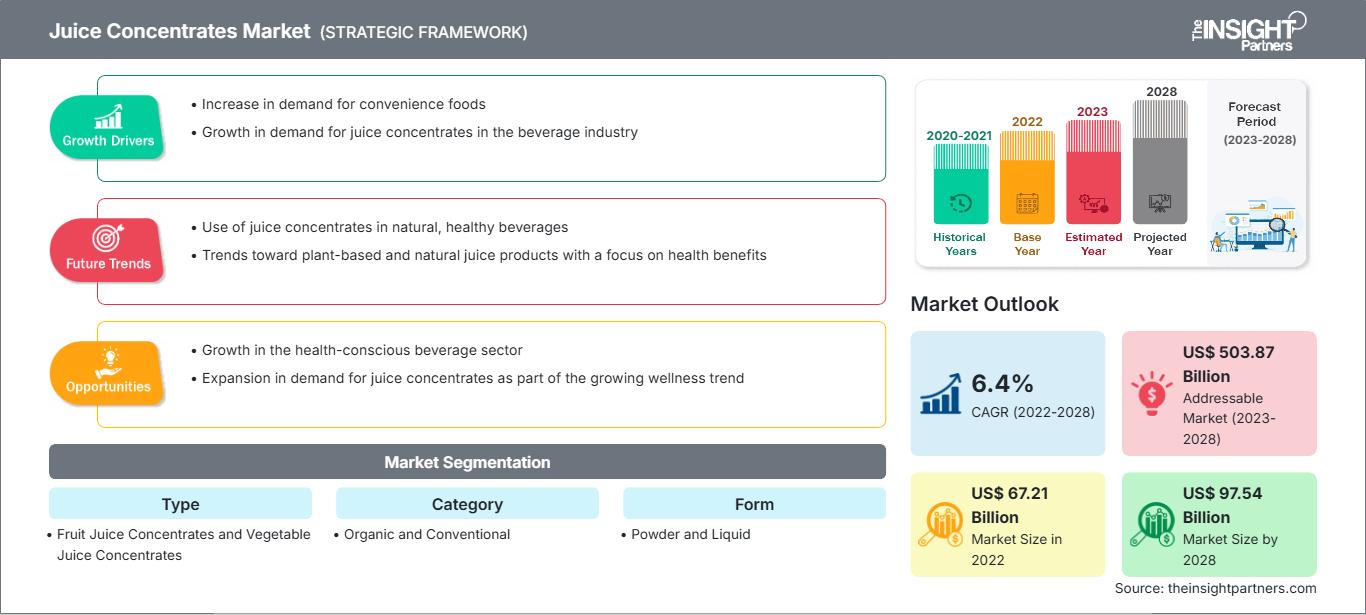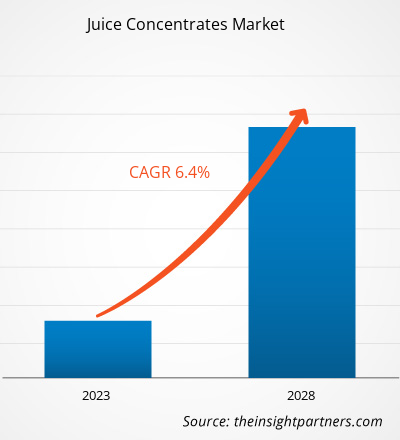预计浓缩果汁市场规模将从 2022 年的 672.1096 亿美元增长到 2028 年的 975.4112 亿美元;预计 2022 年至 2028 年的复合年增长率为 6.4%。
浓缩果汁是通过从水果和蔬菜汁中提取水分制成的。根据加工过程中使用的水果和蔬菜的种类,这些浓缩果汁提供矿物质和维生素等必需营养素。与原汁相比,浓缩果汁经过了高度加工。浓缩果汁中提取水分是为了减少细菌生长。浓缩果汁通常在室温下冷冻保存,然后在食用前用过滤水稀释。浓缩果汁富含维生素 C 和其他抗氧化剂,有助于促进皮肤健康,延缓皮肤老化。消费者通常将其作为鲜榨果汁的健康替代品。
2022年,欧洲占据了浓缩果汁市场的最大份额。预计在预测期内,亚太地区的市场复合年增长率最高。欧洲市场的增长归功于AGRANA Beteiligungs-AG、Archer Daniels Midland Company、Berrifine A/S、Ingredion Incorporated和Dohler GmbH等知名企业的存在。随着消费者健康意识的增强,预计在预测期内,对使用浓缩果汁制成的天然产品的需求将继续增长。此外,由于该地区消费者忙碌的生活方式,对便携式水果饮料的需求也在增加。浓缩果汁和浓缩果汁产品(例如汤、酱汁和饮料)的消费量不断增长,是因为越来越多的消费者,尤其是注重健康的消费者,选择饮用果蔬汁而非碳酸饮料。
自定义此报告以满足您的要求
您将免费获得任何报告的定制,包括本报告的部分内容,或国家级分析、Excel 数据包,以及为初创企业和大学提供超值优惠和折扣
浓缩果汁市场: 战略洞察

-
获取本报告的主要市场趋势。这个免费样本将包括数据分析,从市场趋势到估计和预测。
COVID-19 疫情对浓缩果汁市场的影响
COVID-19 疫情影响了各国的经济和行业。北美、欧洲、亚太地区 (APAC)、南美和中美以及中东和非洲 (MEA) 的封锁、旅行限制和企业倒闭阻碍了多个行业的增长,包括食品和饮料行业。制造部门的关闭扰乱了全球供应链、制造活动、交付时间表以及必需和非必需产品的销售。2020 年,许多公司都出现了产品交付延迟和产品销售下滑的情况。此外,欧洲、亚太地区和北美各国政府对国际旅行实施的禁令,迫使公司暂时中止合作和伙伴关系计划。所有这些因素在2020年和2021年初阻碍了各行各业的发展,从而抑制了包括浓缩果汁市场在内的各个市场的增长。
在新冠疫情爆发之前,由于烘焙产品需求的增加以及各种口味产品产量的增加,浓缩果汁的需求量很高。然而,2020年疫情爆发后,制造业面临着前所未有的挑战。由于全国封锁、贸易禁令和旅行限制导致的供应链受限,浓缩果汁制造商面临诸多挑战。供应链中断导致原材料储存紧张,进而影响了浓缩果汁的生产和分销,最终导致价格上涨。此外,由于封锁和出行限制,市场供需缺口巨大。
市场洞察
主要参与者的战略发展将推动预测期内浓缩果汁市场的增长
2022年5月,AGRANA Beteiligungs-AG(AGRANA)和Raiffeisen Ware Austria AG(RWA)的合资企业Austria JuiceGmbH在其位于上奥地利州克勒伦多夫的浓缩果汁工厂所在地建造了一座大型光伏装置。该公司在该工厂生产浓缩果汁、果泥、天然香料,以及为下游饮料行业生产的复合饮料和非浓缩果汁。预计市场主要参与者的此类战略发展将在未来几年推动浓缩果汁市场的增长。
基于类型的洞察
根据类型,浓缩果汁市场分为浓缩果汁和浓缩蔬菜汁。浓缩果汁细分市场在 2022 年占据了更大的市场份额,而浓缩蔬菜汁细分市场预计在预测期内将实现更高的复合年增长率。浓缩果汁是从果汁中提取水分制成的,它提供一些必需的营养成分,包括维生素和矿物质。通过蒸发去除水分可以将新鲜果汁变成浓缩果汁,浓缩果汁可用作其他食品和饮料产品的调味剂。浓缩果汁通常与水混合,制成美味清爽的果汁饮料。浓缩果汁主要用于制作果汁、软饮料和果蔬汁。
品类洞察
根据品类,浓缩果汁市场分为有机浓缩果汁和传统浓缩果汁。传统浓缩果汁在2022年占据了更大的市场份额,而有机浓缩果汁预计在预测期内将实现更高的复合年增长率。传统的水果和蔬菜种植方式允许使用合成肥料、粪肥、堆肥、污水污泥和其他土壤改良剂。而传统类别的水果和蔬菜则喷洒多种化学肥料、杀虫剂和除草剂,并采用转基因生物技术等人工方法进行种植。因此,传统种植比有机种植更便宜。因此,传统浓缩果汁比有机浓缩果汁更便宜。
基于形态的洞察
根据形态,浓缩果汁市场分为粉末状和液体状。 2022年,液体浓缩汁占据了更大的市场份额,而粉末浓缩汁预计在预测期内将实现更高的复合年增长率。来自水果和蔬菜的溶剂以及采购的植物提取物均以液体形式提供。这种液体提取物可以进一步加工成粉末状,或分销到终端行业用于各种用途。液体浓缩汁是浓缩汁的主要可用形式,因为与其他形式相比,它所需的加工最少。
应用洞察
根据应用,浓缩汁市场细分为烘焙和糖果;饮料;汤、酱汁和调味品;乳制品和冷冻甜点;以及其他。2022年,饮料细分市场占据了最大的市场份额,而烘焙和糖果细分市场预计在预测期内将实现最高的复合年增长率。浓缩果汁广泛应用于制作有机和传统饮料,例如水、果汁饮料、碳酸软饮料、茶饮料、啤酒混合饮料、苹果酒和烈酒,这推动了饮料行业的增长。此外,人们对增强免疫力、健康且功能性饮料的需求不断增长,也推动了饮料行业的增长。一些大型饮料制造商,例如多乐公司 (Döouml;hler),一直在提供多种产品,包括二氧化碳稳定浓缩果汁、澄清浓缩果汁和酒精稳定浓缩果汁。
Ciatti Co、Berrifine AS、Archer-Daniels-Midland Co、AGRANA Beteiligungs AG、Dohler GmbH、Kanegrade Ltd、CitroGlobe SRL、SVZ International BV 和 IPRONA SpA 是浓缩果汁市场的主要参与者。这些公司主要专注于产品创新,以扩大市场规模并紧跟新兴趋势。
浓缩果汁市场区域洞察
The Insight Partners 的分析师已详尽阐述了预测期内影响浓缩果汁市场的区域趋势和因素。本节还讨论了北美、欧洲、亚太地区、中东和非洲以及南美和中美洲的浓缩果汁市场细分和地域分布。
浓缩果汁市场报告范围
| 报告属性 | 细节 |
|---|---|
| 市场规模 2022 | US$ 67.21 Billion |
| 市场规模 2028 | US$ 97.54 Billion |
| 全球复合年增长率 (2022 - 2028) | 6.4% |
| 历史数据 | 2020-2021 |
| 预测期 | 2023-2028 |
| 涵盖的领域 |
By 类型
|
| 覆盖地区和国家 |
北美
|
| 市场领导者和主要公司简介 |
|
浓缩果汁市场参与者密度:了解其对业务动态的影响
浓缩果汁市场正在快速增长,这得益于终端用户需求的不断增长,而这些需求的驱动因素包括消费者偏好的演变、技术进步以及对产品优势的认知度的提升。随着需求的增长,企业正在扩展产品线,不断创新以满足消费者需求,并抓住新兴趋势,从而进一步推动市场增长。

- 获取 浓缩果汁市场 主要参与者概述
报告重点
- 浓缩果汁市场的渐进式行业趋势,帮助企业制定有效的长期战略
- 发达国家和发展中国家市场参与者采用的业务增长战略
- 2022 年至 2028 年的市场定量分析
- 全球浓缩果汁需求估算
- 波特五力分析,阐明浓缩果汁市场中买家和供应商的效力
- 了解市场竞争格局的最新发展
- 浓缩果汁市场的市场趋势和前景,以及增长驱动力和制约因素
- 通过强调支撑商业利益的市场战略来协助决策过程
- 浓缩果汁市场在各个节点的规模
- 浓缩果汁行业的市场详细概述和细分以及增长动态
- 规模各地区浓缩果汁市场均呈现良好的增长机遇
- 历史分析(2 年)、基准年、预测(7 年)及复合年增长率
- PEST和SWOT分析
- 市场规模、价值/数量 - 全球、区域、国家
- 行业和竞争格局
- Excel 数据集
近期报告
客户评价
购买理由
- 明智的决策
- 了解市场动态
- 竞争分析
- 客户洞察
- 市场预测
- 风险规避
- 战略规划
- 投资论证
- 识别新兴市场
- 优化营销策略
- 提升运营效率
- 顺应监管趋势






















 获取免费样品 - 浓缩果汁市场
获取免费样品 - 浓缩果汁市场